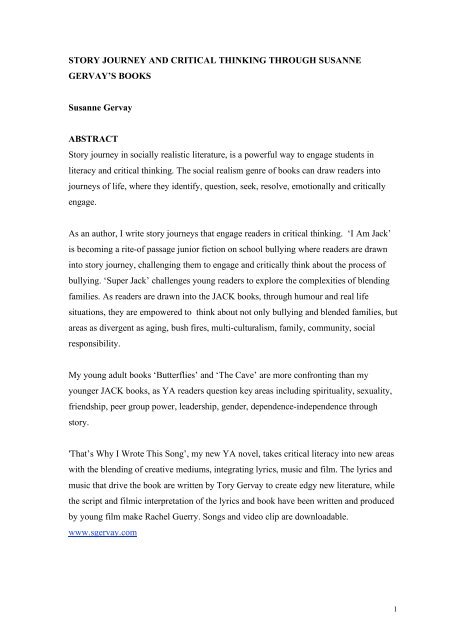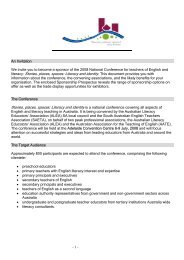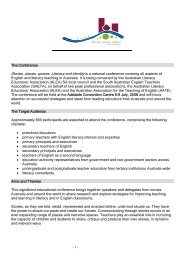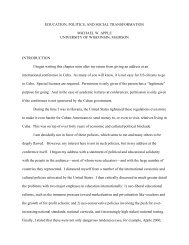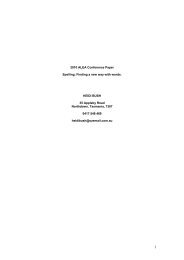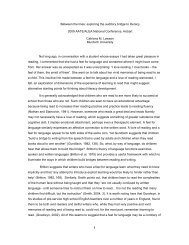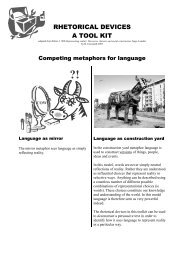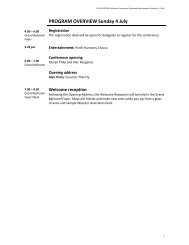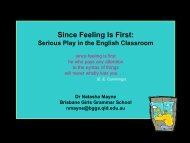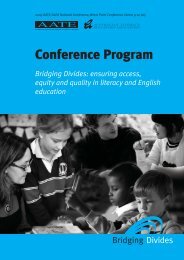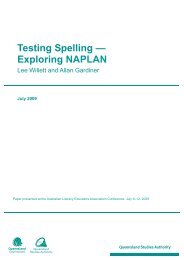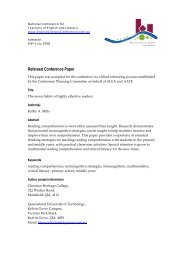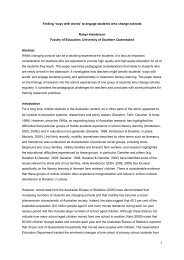Story Journey and Critical Thinking Through Susanne Gervay's Books
Story Journey and Critical Thinking Through Susanne Gervay's Books
Story Journey and Critical Thinking Through Susanne Gervay's Books
You also want an ePaper? Increase the reach of your titles
YUMPU automatically turns print PDFs into web optimized ePapers that Google loves.
STORY JOURNEY AND CRITICAL THINKING THROUGH SUSANNE<br />
GERVAY’S BOOKS<br />
<strong>Susanne</strong> Gervay<br />
ABSTRACT<br />
<strong>Story</strong> journey in socially realistic literature, is a powerful way to engage students in<br />
literacy <strong>and</strong> critical thinking. The social realism genre of books can draw readers into<br />
journeys of life, where they identify, question, seek, resolve, emotionally <strong>and</strong> critically<br />
engage.<br />
As an author, I write story journeys that engage readers in critical thinking. ‘I Am Jack’<br />
is becoming a rite-of passage junior fiction on school bullying where readers are drawn<br />
into story journey, challenging them to engage <strong>and</strong> critically think about the process of<br />
bullying. ‘Super Jack’ challenges young readers to explore the complexities of blending<br />
families. As readers are drawn into the JACK books, through humour <strong>and</strong> real life<br />
situations, they are empowered to think about not only bullying <strong>and</strong> blended families, but<br />
areas as divergent as aging, bush fires, multi-culturalism, family, community, social<br />
responsibility.<br />
My young adult books ‘Butterflies’ <strong>and</strong> ‘The Cave’ are more confronting than my<br />
younger JACK books, as YA readers question key areas including spirituality, sexuality,<br />
friendship, peer group power, leadership, gender, dependence-independence through<br />
story.<br />
'That’s Why I Wrote This Song’, my new YA novel, takes critical literacy into new areas<br />
with the blending of creative mediums, integrating lyrics, music <strong>and</strong> film. The lyrics <strong>and</strong><br />
music that drive the book are written by Tory Gervay to create edgy new literature, while<br />
the script <strong>and</strong> filmic interpretation of the lyrics <strong>and</strong> book have been written <strong>and</strong> produced<br />
by young film make Rachel Guerry. Songs <strong>and</strong> video clip are downloadable.<br />
www.sgervay.com<br />
1
<strong>Story</strong> <strong>Journey</strong> <strong>and</strong> <strong>Critical</strong> <strong>Thinking</strong> <strong>Through</strong> <strong>Susanne</strong> Gervay’s <strong>Books</strong><br />
Challenges are faced by each of us, every day of our life. … <strong>Susanne</strong> Gervay’s novel,<br />
‘Butterflies’ … in particular it is about the emotions <strong>and</strong> consequences faced by one<br />
individual who has been given the opportunity to gain strength <strong>and</strong> build character<br />
around her life.<br />
Life is often not easy, can often by perceived as cruel <strong>and</strong> can be questioned.<br />
However, ‘Butterflies’ shows that life is also full of many wonderful people <strong>and</strong> that<br />
those most important to each of us are our family <strong>and</strong> friends who are there with us<br />
through all our ‘challenges’<br />
Louise Sauvage OAM<br />
World Sportsperson of the Year with a Disability 2000<br />
1999 Australian Female Athlete of the Year.<br />
Louise Sauvage’s comments about my book Butterflies could also have applied to John<br />
Marsden’s award winning novel So Much to Tell about a girl locked into silence until her<br />
reconciliation with her parents; or Christobel Mattingley’s moving story of a refugee<br />
family in Bosnia, No Guns for Asmir; or Colin Thiele’s revelation of heroism of a young<br />
girl with rheumatoid arthritis in Jodie’s <strong>Journey</strong>; or Wendy Orr’s narrative, Peeling The<br />
Onion, which poignantly explores a teenager’s struggles with severe injuries from a car<br />
accident.<br />
Readers through powerful literature can become fellow travellers in story journey,<br />
enabling them to identify with other people <strong>and</strong> the challenges of life. Literacy<br />
incorporates critical thinking through story journey, in a way where readers can gain<br />
insight, develop their strategies for conflict resolution, question, seek, resolve, travel the<br />
many steps towards underst<strong>and</strong>ing <strong>and</strong> the pursuit of knowledge.<br />
As a specialist in child growth <strong>and</strong> development, a parent <strong>and</strong> a children’s <strong>and</strong> young<br />
adult author, I write books to engage, entertain <strong>and</strong> develop constructs of critical<br />
thinking, where youth can move towards developing their self-concept; increase their<br />
2
underst<strong>and</strong>ing of human behaviour <strong>and</strong> motivations; provide a way to find interests<br />
outside of self; achieve emotional underst<strong>and</strong>ing; open the way to self empowerment <strong>and</strong><br />
decision making; <strong>and</strong> share experiences.<br />
Young people read differently to adults, where if a book ‘speaks’ to them, they will read<br />
<strong>and</strong> re-read that book, testing it against their developing value system, incorporating<br />
concepts that they feel are relevant to who they are. So story journey can be a powerful<br />
<strong>and</strong> effective methodology towards critical thinking.<br />
I wrote ‘I Am Jack’ when I discovered that my son Jack, who was 11 years old then, was<br />
being bullied at school. I couldn’t believe that he didn’t tell me. That I didn’t know or see<br />
the signs. I felt I had failed my son even though my children are pivotal to my life.<br />
My son had more courage than I had. Every day he went to school knowing that he had to<br />
face bullying. He was scared <strong>and</strong> felt alone. Why didn’t he tell me I was a sole parent<br />
then, worked, was tired a lot of the time. He wanted to be brave, not put more pressure on<br />
me. That was one reason, but there were others too, such as inexperience in dealing with<br />
aggression, fear of the reaction if he sought help, disempowerment.<br />
As a parent, we want to protect our children, keep them safe. As teachers we want our<br />
children to learn in a safe environment. Bullying makes school a dangerous place rather<br />
than a place where children socialise <strong>and</strong> learn.<br />
It took six months for my son to win against bullying with the support of myself, his<br />
family, teacher, school, the other children <strong>and</strong> of course Jack. From that he has become a<br />
more secure person. He knows that the world can be fair <strong>and</strong> safe. He trusts the system.<br />
He feels positive about himself, has friends, learns <strong>and</strong> embraces the world.<br />
The whole school won too. The teachers <strong>and</strong> school, the other children <strong>and</strong> parents were<br />
also empowered by their actions where they changed the environment of bullying within<br />
their school. The bully was helped as well as he learnt aggression does not pay <strong>and</strong> the<br />
system can work towards helping him. Everyone won against bullying in the end.<br />
3
Linning, Phillips <strong>and</strong> Turton (1997) in a literature based approach to bullying at school,<br />
showed that by taking students on a journey through a book such as ‘I Am Jack’, bullying<br />
can be explored in a non threatening way, creating positive <strong>and</strong> meaningful strategies that<br />
are successful against bullying.<br />
Jenny Foster developed a literacy <strong>and</strong> literature programme using ‘I Am Jack’ which has<br />
been very successful in achieving literacy <strong>and</strong> critical thinking outcomes.<br />
‘Using literature in teaching is a way of connecting across the curriculum <strong>and</strong> creating<br />
powerful learning experiences. A successful cross-curriculum experience using <strong>Susanne</strong><br />
Gervay’s novel, I AM JACK was conducted with a year 5/6 reading group at Winmalee<br />
Public School. The class teacher, working with the teacher librarian, created a unit of<br />
work to achieve reading <strong>and</strong> viewing literacy outcomes, to address values <strong>and</strong> attitudes<br />
of interpersonal behaviours - specifically bullying, <strong>and</strong> to use the library <strong>and</strong> computers<br />
as tools in student learning. The result was an effective unit of work that proved to be<br />
generated much discussion <strong>and</strong> had some interesting spin offs.’ (Jenny Foster, ‘I Am Jack<br />
- Using Literature to Teach about Bullying)<br />
As a follow up to ‘I Am Jack’, I wrote ‘Super Jack’. Like ‘I Am Jack’ it fosters literacy<br />
<strong>and</strong> challenges young people to think critically. Dianne Dempsey (The Age, Review<br />
6/9/2003) wrote:<br />
Every institution from Play-school to kindergarten to schools colludes in the illusion that<br />
life is about Mum, Dad, two kids <strong>and</strong> Big Ted. It is extraordinary, still, that so little is<br />
written <strong>and</strong> so little spoken to help children deal with divorce, which is a major trauma in<br />
the lives of many. Divorce may be common but it is painful. <strong>Susanne</strong> Gervay writes<br />
humorously but with honesty about the rigours of living in a mix-master family.<br />
Jack’s little sister Samantha thinks life with the new stepdad will be all Coke <strong>and</strong> chips<br />
but Jack knows now “there won’t by any night when she can get into Mum’s bed.”<br />
Jack faces the problems of dealing with a new stepdad. A stepbrother <strong>and</strong> also having his<br />
Gran come <strong>and</strong> live with them on a family trip to the Gold Coast. Gervay’s strength lies<br />
not only in her humour <strong>and</strong> honesty but in the fact that her characters are the sort you<br />
4
wouldn’t mind sharing the back seat with. Her language is also rich <strong>and</strong> colourful; her<br />
imagery is there to assist the narrative rather than show off in an ostentatious literary<br />
display. Jack’s little Italian girlfriend Anna has ‘chocolate drop eyes.’<br />
The John Marsdens of the writing scene are very good at top-level abuse <strong>and</strong> the Paul<br />
Jennings are excellent in sheer fun but <strong>Susanne</strong> Gervay is rare in her ability to place<br />
common problems for children within the spectrum of normal family life. The result is<br />
that she makes it OK for the children to talk about them.’<br />
My young adult books (YA) ‘Butterflies’ <strong>and</strong> ‘The Cave’ are more confronting than my<br />
younger JACK books, with search for identity, as the driver, exploring areas such as<br />
spirituality, sexuality, friendship, peer group power, leadership, gender, dependenceindependence.<br />
‘The Cave’ is an uncompromisingly male coming of age novel. It reveals male culture as<br />
young men search for their place in the world today. It explores mateship, independence,<br />
sexuality, leadership, male humour <strong>and</strong> the way they speak, or don't speak. It is about<br />
girls - getting them, discarding them, wanting them. However, ultimately ‘The Cave’<br />
reveals the underbelly of peer group pressure <strong>and</strong> male capacity for violence <strong>and</strong> courage.<br />
’Butterflies’ is an uncompromisingly female coming of age novel. It reveals female<br />
culture as young women search for their place in the world. It explores girlfriends, peer<br />
group pressure, sensitivity, sexuality, independence <strong>and</strong> the way girls speak <strong>and</strong> think. It<br />
is about boys – wanting them, loving them, relationships. Butterflies explores the way<br />
women participate in the world, meeting unique challenges in unique ways.<br />
Butterflies’ <strong>and</strong> ‘The Cave’ invites youth to engage in confronting <strong>and</strong> powerful story<br />
journeys. It allow them to explore, think <strong>and</strong> develop their own pathways to the future<br />
meeting literacy <strong>and</strong> critical thinking outcomes.<br />
An example of one area explored in ‘The Cave’ is war. At a time when boys are facing<br />
the realities of war, when the media confronts them with the heroism <strong>and</strong> horror of it,<br />
‘The Cave’ engenders discussion <strong>and</strong> encourages an emotional engagement in critical<br />
5
thinking. This extract from ‘The Cave’ exemplifies the power of story journey, opening<br />
discussion about war in terms of courage, mateship, leadership, choice. The narrator, Sam<br />
Knox is speaking about his Gr<strong>and</strong>pa, who was in the Australian airforce during World<br />
War 11.<br />
‘He was only twenty years old. Gr<strong>and</strong>pa said that half the airmen didn’t come home.<br />
Lancasters. They could really fly. More than 4000 kilometres in one go, carrying a 7,000<br />
pound bomb load. Lancs. They were fast. 460 kilometres per hour. That might not seem<br />
fast to you Sam, but it was then.” Gr<strong>and</strong>pa had told me about his famous Lancs before –<br />
the airmen, their missions, air battles. Sometimes he repeated himself but he always<br />
added something new, explained something more. “We could go higher than 24,000<br />
feet.” He moved back <strong>and</strong> forward s<strong>and</strong>ing the glory box smooth. “Not much higher<br />
than that.” He stopped to look at the smoothness of his work. I ran my h<strong>and</strong> over it.<br />
“There were always three gunners. I was one of them, sitting in a perspex bubble with a<br />
machine gun on the side of the plane. The gunners were the first target. Had to knock us<br />
out. The noise was deafening.” Gr<strong>and</strong>pa waited. He looked at me for a while. “I want to<br />
tell you this, because I’d didn’t know it when I was a boy back then.” He pointed to the<br />
familiar old black <strong>and</strong> white photograph hanging on the workshop wall. “That was my<br />
first Lanc. The first crew I flew with.” There were seven airmen in the photo, three<br />
wearing peak airmen caps, two with pilot’s hats <strong>and</strong> two with no hats <strong>and</strong> their hair<br />
slicked back. “They were my mates.” He pointed to the second pilot <strong>and</strong> the Navigator.<br />
Then Gr<strong>and</strong>pa waited as if gulping for air. “I didn’t like the skipper at first,” he pointed<br />
to a tall, lean man with a pilot’s hat. “Jack Dawson. Came from Western Australia from<br />
a big station. Ran sheep. I thought he thought too much of himself. He was university<br />
educated. He didn’t talk much. He stood apart from the rest of us. He’d already seen<br />
action in France.” Gr<strong>and</strong>pa stopped his work on the glory box <strong>and</strong> stood in front of his<br />
black <strong>and</strong> white photograph.<br />
“Our mission was Cologne. Night bombing. The Lanc was fully loaded with bombs.<br />
There were German searchlights looking for us. Blue lights that attached to you so that<br />
we were targets for the twin-engined Messerschmitt 110’s. Hated those blue lights <strong>and</strong><br />
the Messerschnitts. Deadly. Then there was the ground cannon. There was so much<br />
6
noise <strong>and</strong> smoke, planes down, bombing, fire. Jack took down our Lanc to 2000 feet,<br />
unloading bombs onto cities of people <strong>and</strong> falling buildings. Flak struck the Lanc, tore<br />
the guts out of the side. A shell exploded in the cockpit shattering the windscreen <strong>and</strong> the<br />
second pilot’s leg but it was Jack who got the full blast of it.” Gr<strong>and</strong>pa put his heavy<br />
carpenter h<strong>and</strong>s in front of his face as if to hide the image. “A shell ripped away his right<br />
eye <strong>and</strong> the skin of his face.” It was a while before he started speaking again. “We were<br />
screaming <strong>and</strong> firing <strong>and</strong> trying to fix the damage. Jack lost consciousness <strong>and</strong> we<br />
plummeted 800 feet before he pulled the plane out of the dive. I don’t know how he did.<br />
Even in that much pain, coughing blood, Jack has this strength. He was losing blood. A<br />
lot of blood <strong>and</strong> his face was half torn away. Bone <strong>and</strong> flesh <strong>and</strong> eyes.<br />
Jack held that plane level, but we were low, lurching in the sky. Flak was still hitting us<br />
but Jack held onto that plane, crossing the English Channel in the dark. We couldn’t<br />
l<strong>and</strong>. Not enough fuel. Too much damage. One gunner was dead. We reached the<br />
English coastline. Jack could hardly speak. “Parachutes. Get out of here.” There was so<br />
much blood. “An order.”<br />
We left Jack. Jumped. They found his body weeks afterwards, brought in with the tide on<br />
a beach.<br />
Gr<strong>and</strong>pa was careful not to judge people too quickly after that. Gr<strong>and</strong>pa told me that war<br />
is not brave, but men can be brave in war <strong>and</strong> in life.’ (Chapter 14 in ‘The Cave’)<br />
An example from ‘Butterflies’ of story journey <strong>and</strong> the challenge to think critically is the<br />
emotional response of the mother to her daughter’s accident. The scene is in the hospital<br />
with the mother <strong>and</strong> Katherine, her baby daughter.<br />
‘Swollen eyelids shut tight. Head shaven bare. The woman strokes the baby’s face. A<br />
seven year old girl holds onto the woman’s skirt. A plastic tube feeds into the baby’s<br />
nose <strong>and</strong> a drip is taped onto her arm. A catheter empties urine into a bag. Her arms are in<br />
splints. Her small body wrapped in gauze. Her h<strong>and</strong>s are in mittens also tied to splints.<br />
She tries to open her eyes, searching through the swelling,<br />
7
The nurse comes to check tubes <strong>and</strong> vital signs.<br />
The woman brushes back her dark wispy hair <strong>and</strong> looks up at the nurse. “What is wrong<br />
with that baby Where is her hair... Her face ... Her body”<br />
“Remember the doctor spoke to you about it” The nurse’s voice gently persists..<br />
“Remember Remember”<br />
“No. Spoke to me No.”<br />
“About her body, her face.” Pulling a chair close, the nurses sits next to her. “The baby<br />
will .... she will ..... look a little different.”<br />
The woman stares confused at the nurse in her white uniform. “Where is Katherine<br />
Where is my baby My little girl”<br />
The nurse answers softly. “This is Katherine. You can see her.”<br />
“But I can’t. I can’t .... see her. I can’t see her.”<br />
“Katherine, are you ready” Mum calls as she comes into the house. She stops when she<br />
sees her daughter with her long brown hair flowing <strong>and</strong> the warmth of black velvet<br />
embracing her. “You look beautiful.”<br />
“That’s what mothers are supposed to say.”’ (Chapter 5, ‘Butterflies’)<br />
‘The new English Senior Secondary syllabuses reflect the fact that the world continues to<br />
change - socially, technologically <strong>and</strong> economically. The study of a wide range of<br />
spoken, written, visual, multimedia <strong>and</strong> performance texts remains central to the<br />
syllabuses. Students will continue to learn about themselves, the world <strong>and</strong> what it is to<br />
be human through the study of texts <strong>and</strong> language. The syllabuses will enable students to<br />
underst<strong>and</strong> the structures <strong>and</strong> features of texts, the role of context in creating <strong>and</strong><br />
interpreting texts <strong>and</strong> how texts can shape values <strong>and</strong> ideologies.’<br />
(http://wwwfp.education.tas.gov.au/English/default.htm Education Department<br />
8
Tasmania). <strong>Critical</strong> thinking is integral to the English curricula throughout Australia <strong>and</strong><br />
is now encouraging a multi disciplinary <strong>and</strong> multi mediums approach.<br />
My break though new YA novel, ‘That’s Why I Wrote This Song’ has crossed into new<br />
ground through integrating music, technology, film in a collaborative cross-generational<br />
novel. My teenage daughter Tory Gervay, wrote the lyrics <strong>and</strong> music that drive the<br />
narrative, characters <strong>and</strong> themes. I wrote the book which incorporates her written lyrics.<br />
Tory’s songs, ‘Psycho Dad’ <strong>and</strong> ‘I Wanna Be Found’ which she sang <strong>and</strong> recorded, can<br />
be downloaded from the web. The video clip of ‘Psycho Dad’ can also be downloaded.<br />
The book or music or video clip are all entry points into the experience of ‘That’s Why I<br />
Wrote This Song’.<br />
‘That’s Why I Wrote This Song’ is the journey of four sixteen-seventeen year old girls<br />
connected through music. It reveals their relationships with their fathers <strong>and</strong> how that<br />
impacts on their relationship with boys, each other <strong>and</strong> their lives. It explores the issue of<br />
identity in its varied aspects from dependence-independence, friendship, mother-daughter<br />
relationships, sexuality to promises <strong>and</strong> hopes, set against the real youth music scene. It<br />
invites critical thinking about father-daughter relationships; <strong>and</strong> music as the voice of<br />
youth.<br />
Detailed Teaching Notes are available online from my website <strong>and</strong> the HarperCollins<br />
website for ‘That’s Why I Wrote This Song’.<br />
Aristotle advocated reading fiction as a way to purge illness, leaving the reader healthier<br />
<strong>and</strong> sounder of mind. ‘The Medicine Chest for the Soul’, is found inscribed at the<br />
doorway of the medieval Abbey Library of St. Gall, in Switzerl<strong>and</strong>. <strong>Story</strong> journey is a<br />
potent way to engage young people in critical thinking giving them invaluable insights<br />
into themselves <strong>and</strong> their world. I seek to write those books for young people.<br />
9
REFERENCES<br />
Teaching Notes are available online through the websites:-<br />
<strong>Susanne</strong> Gervay – www.sgervay.com<br />
HarperCollins – www.harpercollins.com.au<br />
<strong>Susanne</strong> Grevay, That’s Why I Wrote This Song, HarperCollins Publishers<br />
<strong>Susanne</strong> Gervay Butterflies HarperCollins Publishers<br />
<strong>Susanne</strong> Gervay The Cave HarperCollins Publishers<br />
<strong>Susanne</strong> Gervay, I Am Jack, HarperCollins Publishers<br />
<strong>Susanne</strong> Gervay Super Jack, HarperCollins Publishers<br />
I Am Jack <strong>and</strong> Super Jack audio by Vocaleyes, Southern Scene :<br />
info@southernscene.com.au<br />
Detailed teaching notes are available for a unit on ‘I Am Jack’ in:-<br />
‘I am Jack’: Using Literature to Teach about Bullying by Jenny Foster, SCAN, The NSW<br />
Department of Education & Training Vol 21 No. 3 August 2002,<br />
www.det.nsw.edu.au/schoollibraries available on <strong>Susanne</strong> Gervay’s website<br />
www.sgervay.com<br />
Linning, Phillips & Turton in ‘A Literature based approach to bullying, The Literature<br />
Base (1997)<br />
Rigby, Ken ‘What children tell us about bullying in schools,’ Children Australia vol 22,<br />
no 2, 1997<br />
10


